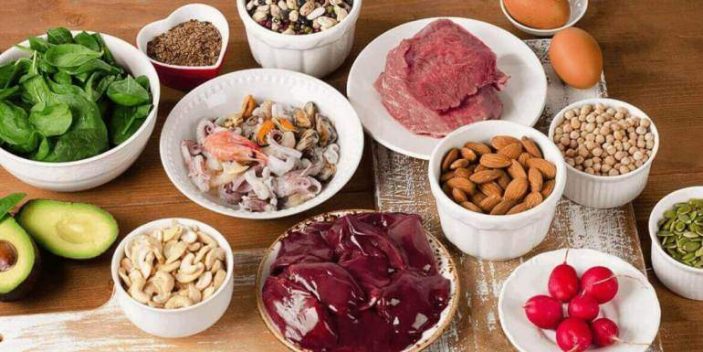Iron (Fe) is an essential mineral required by various animals including cats but in the right amounts as too much will lead to toxicity while too little will result in iron-deficiency anemia.
However, feline anemia is hardly caused by iron deficiency but other diseases and conditions including excessive blood loss.
Absorption
This mineral is absorbed in the intestine mainly in the ionized ferrous (Fe2+) and ferric (Fe3+) forms. However, its oxide (rust) and metallic forms are not readily absorbed.
Absorption occurs across mucosal cells in the duodenum and jejunum. The presence of vitamin C and sugar promotes its absorption while high phosphate diets reduce absorption.

Normally, a cat’s body can absorption about 2-15% of iron available in diets, only 0.01% of the total amount in the body is eliminated.
Once absorbed it gets bound to glycoprotein transferrin and transported to the liver, spleen, bone marrow and so on where it is used or stored as hemosiderin (iron storage complex) and ferritin (a protein that stores and releases iron depending on the amounts required in a controlled manner).
Most of the Fe in a cat’s body is found in red blood cells (over 70%) and the myoglobin muscle cells have about 5-10%. However, there is also some found in certain proteins involved in energy metabolism and respiration besides the amount that is in the cat’s body stored as already noted.
Finally, since red blood cells are replaced after about 110, there should also be a constant supply to make new ones.
Cat food high in iron
If you want foods high in this mineral, you need to consider foods that have it naturally or those that it has been added or supplement.
Dietary sources
Iron-rich foods include organ meats (such as liver, kidney, brain, and heart), turkey, red meat, shellfish, sardine, spinach, legumes, pumpkin seeds, quinoa among other foods.
If you opt for diets such as liver, you need to ensure you balance the level of other nutrients especially vitamin A since excessive amounts can cause hypervitaminosis A or vitamin A toxicity.
Commercial feline diets with iron
In commercial foods, more bioavailable forms are added to ensure these diets have the recommended amounts.
There are cat food brands high in iron especially those whose primary ingredients are fish, turkey, red meat, shellfish, and so on.
Such brands include Hound and Gatos, Lotus, Wild Calling, Tiki Cat and Instinct by Nature’s Variety canned foods among others have this mineral. If you need dry ones, brands such as Power of Nature and Ziwipeak will be a good choice.
Consider supplements
Finally, in some cases, you may consider iron supplements for cats if these pets have any of the various deficiency symptoms we will mention later.
Functions
Iron functions include:
- It is a component of hemoglobin and myoglobin which are pigments that carry oxygen in red blood cells and muscles respectively.
- It is involved in energy metabolism (ATP production)
- It helps maintains normal body immunity (specifically in lymphocytes proliferation as well as maturation).
- it is needed by some enzymes for normal function.
Recommended minimum amount
According to AAFCO (2014), the minimum recommended amount of iron is 80mg per kg of cat food on dry matter basis for growth, reproduction and adult maintenance. Basing on calorific content, the amount required is 20mg per 1000kcal ME.
However, AAFCO notes that “because of very poor bioavailability, iron from carbonate or oxide sources that are added to the diet should not be considered in determining the minimum nutrient concentration.”
Deficiency signs
Iron deficiency in cats will result in both low red blood cells and low hemoglobin content since as already noted, this mineral is a component of hemoglobin and it consequently required in the production of red blood cells. Such cells will carry less oxygen.
The deficiency may as a result of inadequate amounts in diets (an uncommon cause), gastrointestinal issues, underlying disease and condition, blood-sucking parasites (such as fleas, ticks, and hookworms), blood loss, among others causes.
Symptoms will depend on the severity of the deficiency and it often leads to iron-deficiency anemia in cats. Commonly noted ones include.:
- Diarrhea
- Weakness
- Poor growth
- Mucous membrane appearing pale
- Susceptibility to illnesses and stress
It is possible for kittens to be born with a low amount of this mineral if their mother did not have enough. In such a case, supplementing it to their mother will not help since it will not increase the amount in milk, notes Pet Coach.
Iron toxicity in cats
Excess amount of this mineral will lead to toxicity. However, toxicity rarely arises from dietary sources. Instead, it can occur from ingestion of human pills rich in iron at home or some human multivitamins.
Common signs of this poisoning include vomiting and diarrhea, lethargy, drowsiness, hypovolemic shock, depression, abdominal pain, among others. See more on iron poisoning in cats including diagnosis and treatments.

How do you get a cat to eat animal food that is good for him.